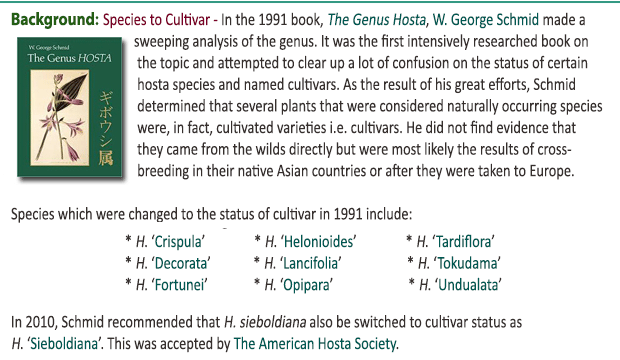|
 This
medium size (15 inches high by 36 inches wide) came
from
Japan and is of unidentified parentage. It was first described by famed
horticulturist,
Liberty Hyde Bailey in 1930 and, at one time, was considered
a separate species under the name Hosta decorata. It was
changed to cultivar status in
The Genus Hosta by W. George Schmid (1991) and is correctly known
as H. 'Decorata'. This
medium size (15 inches high by 36 inches wide) came
from
Japan and is of unidentified parentage. It was first described by famed
horticulturist,
Liberty Hyde Bailey in 1930 and, at one time, was considered
a separate species under the name Hosta decorata. It was
changed to cultivar status in
The Genus Hosta by W. George Schmid (1991) and is correctly known
as H. 'Decorata'.
 In
2002, H. 'Decorata' was registered by
The American
Hosta Society since the originator was unknown and
re-registered
with new data in 2018. Its foliage
is dark green with a creamy white marginal
variegation with some gray streaking. The leaves are
slightly shiny on top and very shiny beneath. They
are lightly folded, slightly wavy and lightly
corrugated. It bears dark purple, bell-shaped
flowers with stripes from July into August followed
by viable seeds. In
2002, H. 'Decorata' was registered by
The American
Hosta Society since the originator was unknown and
re-registered
with new data in 2018. Its foliage
is dark green with a creamy white marginal
variegation with some gray streaking. The leaves are
slightly shiny on top and very shiny beneath. They
are lightly folded, slightly wavy and lightly
corrugated. It bears dark purple, bell-shaped
flowers with stripes from July into August followed
by viable seeds.
 The registration materials state: "...historic plant; tough;
hardy; blunt leaves...W. George Schmid, in The Genus Hosta,
Timber Press, 1991, reduced this hosta from a species to
Cultivar status. The registration information was supplied by P.
Ruh and is gratefully acknowledged by the Registrar." The registration materials state: "...historic plant; tough;
hardy; blunt leaves...W. George Schmid, in The Genus Hosta,
Timber Press, 1991, reduced this hosta from a species to
Cultivar status. The registration information was supplied by P.
Ruh and is gratefully acknowledged by the Registrar."
This plant is one of a handful of
rhizomatous hostas which also includes those from the
species, H. clausa. As a result, it makes a good ground cover or edging
plant.
 This is also an example of the
same plant having more than one name. According to
The Hosta Handbook by Mark Zilis (2000), this plant is actually H. 'Decorata'
although it has been sold under the 'Thomas Hogg' name for
years. Also, H. 'Undulata Albomarginata' was historically sold as H. 'Thomas
Hogg' in
England . This is also an example of the
same plant having more than one name. According to
The Hosta Handbook by Mark Zilis (2000), this plant is actually H. 'Decorata'
although it has been sold under the 'Thomas Hogg' name for
years. Also, H. 'Undulata Albomarginata' was historically sold as H. 'Thomas
Hogg' in
England .
The New Encyclopedia of Hostas by
Diana
Grenfell (2009) states: "Although it can be difficult in a garden setting,
it can be very effective if left alone to increase
around trees or in light woodland."
Thomas Hogg, Jr. was a plant explorer who some credit with
being the one to introduce the species hosta in the trade in
America and Europe.
This plant may have been sold at one time as
'Mackwood No. 12'.
|
 |
|
 |
 |
|
|
"I often
wonder why this classic speciod is not
on the "most popular" list. It has a
very characteristic and unique leaf
shape and beautiful early flowers. It is
stoloniferous and if left alone will
make a large colony. A superb ground
cover...I would not be without it." |
|







 |



